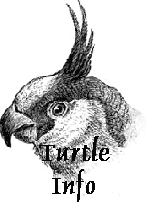
    
|
|
Birds do not respond to physical punishment well. If your bird does something you consider wrong, DO NOT HIT THE
BIRD! Handfed babies are people-oriented, and the best kind of punishment for them is being removed from the presence of
people for a short time. A loud "NO!" when you catch the bird biting, chewing something forbidden, or climbing off-limits
areas, followed by a quick trip to its cage for ten to twenty minutes is adequate punishment. Keeping a smaller "jail" cage (a pet
carrier will do) nearby is handy so you don't have to walk all the way across the house every time you need to discipline the
bird. Most young baby birds do not know how to bite maliciously, but they will bite if afraid. They will also go through a phase
known as "beaking". During this time, they will try to bite and chew everything they encounter to see what is edible and what is
chewable (conures are born with a need to chew things up). This is their way of learning about the world. Your bird will
probably repeatedly attempt to chew your fingers. When it starts trying to chew them, tell it "No bite" in a quiet tone of voice.
If it doesn't stop, change your tone of voice to a slightly harsher one. If it starts chewing harder, blow a short, hard puff of air in
its face, and say loudly "NO BITE!". Also, quickly dropping the hand the bird is perched on (by just a couple inches) will put it
off-balance and make it let go. This idea of "causing an earthquake" is very effective in preventing biting-- every time the bird
tries to reach for you, give it an "earthquake". It should soon associate cause and effect, and stop trying to bite.
If the bird really does cause someone pain, a consistent course of action is required. What we do at our house is this: if the bird offends someone, that person is the one to discipline the bird and rush it to its cage to be locked up. That same person is the one to let it out at the end of the lockup time. Whatever you decide upon for "punishment", you must be sure to respond the same way every time the bird does something undesirable-wishy-washy training will result in an unpredictable bird that can't be trusted. Don't give up-the bird will eventually learn. This "beaking" phase usually lasts until the bird is about six to eight months old. The inborn need to destroy paper and wood, however, will last as long as the bird does, so never leave your parrot alone near anything you want to keep intact. A great book to read on bird behavior modification is "Guide to a Well-behaved Parrot" by Mattie Sue Athan. This book is inexpensive, and covers ways of dealing with many behavior problems in more detail than I can cover here. If you want to try to teach your bird to do tricks, you must first have a good day-to-day relationship with it. Let it learn to love you and get used to your home before you try to teach it anything. A good book to use to teach tricks is "How To Train Your Pet Like A Television Star" by Ray Berwick. This book demonstrates gentle teaching methods which will work on your bird, provided that you are persistent.
email me Thanks to Detroit Download Central |